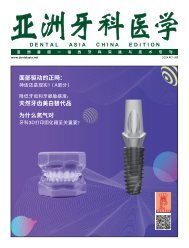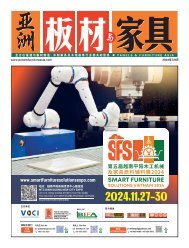Water & Wastewater Asia May/June 2019
Water & Wastewater Asia is an expert source of industry information, cementing its position as an indispensable tool for trade professionals in the water and wastewater industry. As the most reliable publication in the region, industry experts turn this premium journal for credible journalism and exclusive insight provided by fellow industry professionals. Water & Wastewater Asia incorporates the official newsletter of the Singapore Water Association (SWA).
Water & Wastewater Asia is an expert source of industry information, cementing its position as an indispensable tool for trade professionals in the water and wastewater industry. As the most reliable publication in the region, industry experts turn this premium journal for credible journalism and exclusive insight provided by fellow industry professionals. Water & Wastewater Asia incorporates the official newsletter of the Singapore Water Association (SWA).
You also want an ePaper? Increase the reach of your titles
YUMPU automatically turns print PDFs into web optimized ePapers that Google loves.
INSIGHT | 43<br />
IntelliSAW is well known as one of the leading providers of systems that protect electric power transmission and distribution equipment<br />
by measuring and monitoring temperature, humidity, and partial discharge using advanced sensor and analytic technologies. In 2015,<br />
the company was acquired by Emerson.<br />
Now part of Emerson’s Rosemount portfolio of measurement and analytical technologies, the IntelliSAW suite of predictive maintenance and<br />
continuous monitoring systems enables users to reduce maintenance costs and increase their quality of service by providing continuous<br />
real-time temperature data. The non-invasive systems also increase personnel safety and protect equipment from significant damage.<br />
<strong>Water</strong> & <strong>Wastewater</strong> <strong>Asia</strong> recently sat down with Jay Ganson, director of products at Emerson Automation Solutions, to find out more about<br />
IntelliSAW and what it can do to distribute critical electrical power transmissions in plants to avoid failures in critical electrical assets.<br />
Q: Could you describe IntelliSAW to us in detail?<br />
JG: The IntelliSAW product line-up of Emerson focuses on providing<br />
continuous monitoring of electrical infrastructure to any industrial<br />
site, including wastewater treatment plants. In most electrical sites,<br />
I mean every site, we use low-voltage everywhere.<br />
Oftentimes, the electrical delivery which is critical to making sure<br />
everything works is under-invested or ignored. If you look at the<br />
maintenance budget across a lot of plants and operations, one of<br />
the last things to get attention and investment dollars is the power<br />
delivery.<br />
Our solution is designed to retrofit into existing power delivery<br />
equipment and monitor the three most important elements of, or<br />
leading indicators of failure for electrical equipment. Our system is<br />
designed to monitor each one of these points and let operators know<br />
of any issues prior to any failure. We’re bringing the familiar IoT world<br />
into the underinvested area of electrical delivery inside the building; so<br />
we focus on balance of plants, delivery, in addition to sort of a process.<br />
Q: How exactly does IntelliSAW work?<br />
JG: The way that our sensors work is by using a surface acoustic<br />
wave technology. It’s a long-proven technology, but using it in this<br />
application is relatively new — as in the way that we’re using it to<br />
monitor electrical switch gear. It has a lot of neat properties that<br />
make it attractive for this space. Adding sensors, getting data, making<br />
decisions based on that data and improving throughput, that’s a hot<br />
trend, but it’s only starting now to get into the electrical delivery side.<br />
The technology choice of surface acoustic wave that we’re using is<br />
a unique fit for electrical assets. It’s a completely analogue solution,<br />
and the reason that that’s kind of important is that it is very costly to<br />
shut down electricity in a building, so we want to do it as few times<br />
as possible. Our solution doesn’t have a battery, it’s not battery<br />
powered, it has no electrical components that could fail in the powered<br />
equipment.<br />
And that’s important because you don’t want to have to go in and<br />
replace a battery periodically or do maintenance. We’re designed to<br />
be installed for 20 years and be left alone for the life of the asset,<br />
which you can’t say about most powered electronics – there are so<br />
many things that could fail in them and by having it completely RF<br />
and analogue inside the high voltage area, we can eliminate the risk<br />
of that failure. We’re relying on basic physics: when things get hot,<br />
they expand, when things get cold, they contract, so we’re monitoring<br />
that type of basic principle of physics using analogue technology,<br />
sort of an old-school approach to a new problem.<br />
Q: How will IntelliSAW help extend the lifespan of plants?<br />
JG: In plants there are signs that old equipment is failing, and the<br />
problem right now is a lot of people don’t actually have a monitor for<br />
those signs. They leave them out and operate until they smell smoke,<br />
which is already a failure hot enough to create smoke, and that’s a<br />
problem. That issue should have been caught well in advance, but<br />
there just isn’t any sensors in any of this equipment.. No one really<br />
knows when that equipment will fail. Is that five years from now,<br />
15 years or a week?<br />
Electricity is normally incredibly reliable, and so it’s often<br />
underinvested — but when you have data, you might see a<br />
degradation of performance; such as a motor might slow down or<br />
give way, and you have some kind of warning that it’s the end of its<br />
life. With electrical assets you don’t really see that often, so people<br />
don’t think about replacing it until there’s a big failure.<br />
For electrical assets, they’re not digital for the most part, they’re old<br />
school, electro-mechanical things that people don’t expect to fail.<br />
And they work reliably — it’s almost as if it’s a service, but not the<br />
necessary equipment behind that, so you depreciate it. And once<br />
it’s depreciated even after 10 years, if you can get 15 or 20 years<br />
out of it, then it’s great. We find that lots of operators will run their<br />
equipment much longer than the expected life of the asset, at least<br />
for the manufacturer.<br />
<strong>Water</strong> & <strong>Wastewater</strong> <strong>Asia</strong> • <strong>May</strong> / <strong>June</strong> <strong>2019</strong>


















